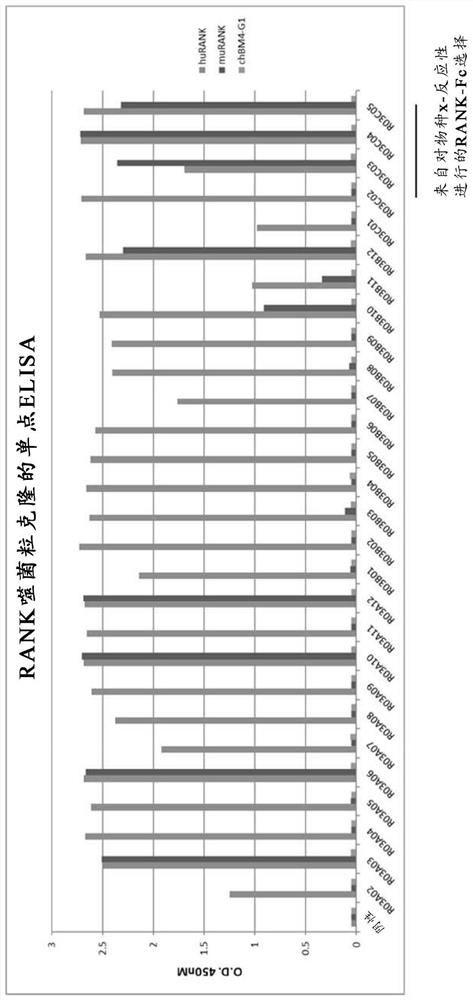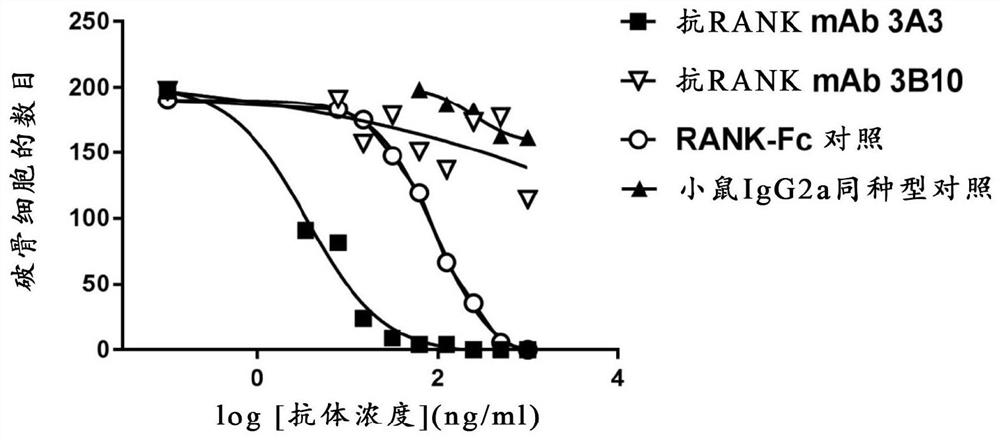Rank antagonists and uses therefor
An antagonistic, therapeutic agent technology, applied in the field of antagonistic antigen-binding molecules, can solve problems such as unpredictable antagonistic activity
- Summary
- Abstract
- Description
- Claims
- Application Information
AI Technical Summary
Problems solved by technology
Method used
Image
Examples
Embodiment 1
[0642] Isolation of Antagonist Anti-RANK Antigen-Binding Molecules
[0643] A fully human Fab based antibody phage display library was obtained from CSL (Parkville, Melbourne, Victoria, AUS). General procedures for construction and screening of human Fab libraries are described in de Haard et al. (1998, Advanced Drug Delivery Reviews 31, 5-31; 1999, J. Biol. Chem. 274:18218-18230).
[0644] Screen the library for Fab fragments that bind to the entire recombinant extracellular region of the RANK protein to facilitate the identification of Fabs that target epitopes within the CDR2 and CDR3 regions, resulting in antagonism of RANKL and cross-reactivity with mouse RANK combined.
[0645] Immobilized on M-280 streptavidin (Invitrogen TM , Thermo Fisher Scientific 11205D) on the RANK-Fc protein to screen phagemid library RANK binders. Selection was performed as previously described (Hoet et al., 2005. Nat Biotechnol. 23(3):344-348; Panousis et al., 2016. MAbs8(3):436-453). Bri...
Embodiment 2
[0653] Antagonistic activity of anti-RANK antibodies in cell-based functional assays
[0654] To evaluate the functional inhibitory effect of the 3A3 antibody in a cell-based functional assay, the effect of this anti-RANK antibody on osteoclastogenesis in vitro was tested. The method used for the in vitro TRAP+ osteoclast assay was essentially as described (Simonet et al., 1997. Cell 89(2):309-319). Bone marrow (BM) cells from normal BL / 6 mice were plated in a 96-well flat bottom plate at a density of 25,000 cells / well, and human recombinant CSF-1 (Preprotech ) in complete DMEM (10% FCS+PS+Glu). After 48 hrs of culture, the medium was replaced with complete DMEM supplemented with 50 ng / mL of human recombinant CSF-1 and 200 ng / mL of soluble muRANKL or soluble huRANKL (Miltenyi). Cells were cultured with CSF-1 and human RANKL or mouse RANKL for 4 days (with and without antibody inhibitors), and then TRAP+ multinucleated (more than three nucleated) osteoclasts were counted. Os...
Embodiment 3
[0660] Dual blockade of RANK and PD-L1 significantly enhances tumor immunity in fibrosarcoma
[0661] In view of the results presented in Example 2 (which demonstrate that in a cell-based RANKL / RANK antagonism assay (osteoclastogenesis in vitro), anti-RANK 3A3 antibodies have at least equivalent activity compared to the positive control RANK-Fc), The efficacy of dual blockade of RANK and PD-L1 in subcutaneous tumor-bearing mice was assessed using antagonistic anti-RANK and anti-PD-L1 antibodies. In the anti-PD-L1-sensitive MCA1956 fibrosarcoma model, the addition of antagonistic anti-RANK mAb was shown to significantly enhance anti-PD-L1 efficacy ( Figure 5 , P<0.0001). This observation supports that antagonistic anti-RANK3A3 antibodies can enhance anti-tumor immunity.
PUM
 Login to View More
Login to View More Abstract
Description
Claims
Application Information
 Login to View More
Login to View More - R&D
- Intellectual Property
- Life Sciences
- Materials
- Tech Scout
- Unparalleled Data Quality
- Higher Quality Content
- 60% Fewer Hallucinations
Browse by: Latest US Patents, China's latest patents, Technical Efficacy Thesaurus, Application Domain, Technology Topic, Popular Technical Reports.
© 2025 PatSnap. All rights reserved.Legal|Privacy policy|Modern Slavery Act Transparency Statement|Sitemap|About US| Contact US: help@patsnap.com



